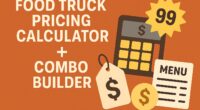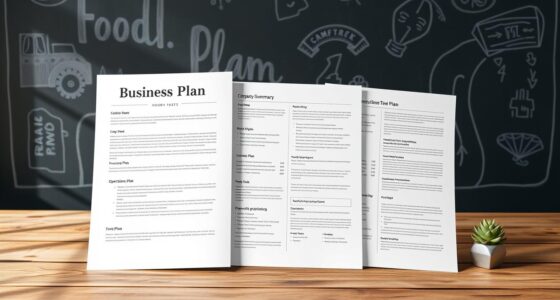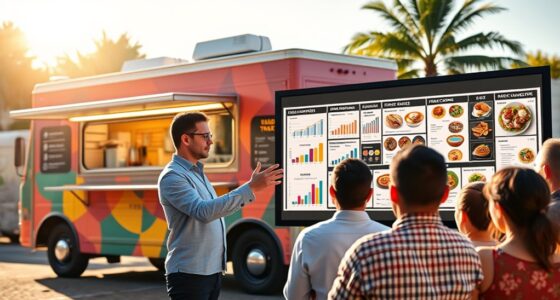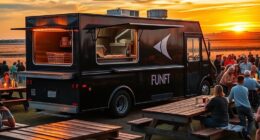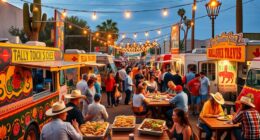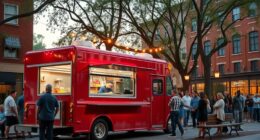By TruckTasting • Practical steps, templates, and a free startup workbook.
⬇️ Download the Food Truck Startup Workbook (Excel)
Quick Start
Decide your concept → Prove it → Paperwork → Build/Buy the truck → Launch with a focused calendar.
- Concept: 3–5 signature items: one crowd‑pleaser, one premium, one vegetarian/vegan or allergy‑friendly, one kid‑friendly/snackable.
- Prove it fast: Weekend pop‑up or friends‑and‑family tasting. Targets: Food cost 25–35%, average order value in the local lunch band, throughput 20–40 tickets/hour (lunch) or 30–60/hour (festivals).
- Paperwork: Business registration/EIN, mobile food/health permit, commissary letter, fire inspection/tags, general liability & commercial auto, workers’ comp (if employees), parking/vending permits, temporary event permits.
- Truck/trailer: Hood/suppression as required, handwash + 3‑comp sinks, safe propane setup, compliant refrigeration, quiet inverter generator or shore power kit.
- Launch plan (first 60–90 days): Breweries, office parks, farmers markets, 2–3 festivals, 1–2 repeating weekly stops, social + local PR.
Plan the Business & Numbers
Menu & Packaging
- Open with a tight menu (3–6 items) to keep lines moving and reduce waste.
- Standardize portioning (portion cups, squeeze bottles); pre‑batch where safe.
- Use packaging that works for one‑hand eating.
Pricing That Works
Price = Food Cost ÷ Target Food Cost % (e.g., target 0.28–0.32). Include disposables in your food cost. Add a combo to lift average order value.
Festival math (example):
Attendance 5,000 × capture 3% = 150 orders.
AOV $16 → Sales $2,400.
COGS 30% ($720), Labor $600, Booth fee $500 → Profit $580, ROI on fee 116%.
Throughput goal (6‑hr day): 25 tickets/hour (~1 order every 2.4 minutes).
Budget & Runway
Major buckets: vehicle/trailer, equipment & suppression, permits, insurance, POS/tech, initial inventory, branding, contingency 10–15%. The workbook’s Startup Budget sheet totals this for you.
Permits, Safety & Infrastructure
- Commissary: Often required for prep, water fill, waste disposal, and cold storage. Keep a signed agreement on the truck.
- Sinks & water: Handwash + 3‑comp sinks; hot water; potable/grey tanks sized to menu; sanitizer buckets made and tested daily.
- Fire & gas: Vent hood/suppression where required; Class K & ABC extinguishers; propane lines secured; current inspection tags.
- Cold chain: Cold holding ≤ 41°F (5°C) with logs; calibrate thermometers.
- Food safety: At least one certified manager on staff; allergen protocol posted.
- Vehicle: Commercial insurance; legal parking plan; weight/axle ratings respected.
Regulations vary by city/state. Check your local health department and fire marshal requirements.
Equipment & Build Decisions
- Truck: All‑in, easier to move; higher purchase/maintenance.
- Trailer: Lower cost, flexible sizes; needs tow vehicle; great for festivals.
- Cart/tent: Lowest cost; limited menu; often requires temp event permits.
- Power planning: Know your total amp draw; carry heavy‑gauge cords; GFCI protection; backup small inverter when possible.
- Line layout for speed: Cook + expeditor + cashier is a strong opening crew; design the pass so one person can assemble 70–80% of orders.
People, SOPs & Daily Flow
- SOPs: Opening/closing, temp logs, sanitation, propane swaps, generator checks, cash handling, incident reporting.
- Staffing: Cross‑train; use compact shifts (e.g., 10:00–14:30 lunch).
- Training: Knife safety, burns, slips, allergen handling, guest recovery.
Simple Tech Stack
- POS: Offline mode + tap‑to‑pay + item photos.
- Order‑ahead/QR: Speed up lunch rush and festival lines.
- Marketing: Google Business Profile + Instagram/TikTok; a single‑page site with your live schedule.
Go‑to‑Market Playbooks by Scenario
A) Festivals & Events
Where to start: Look for aligned demographics and reasonable capture (2–5% is realistic when well placed). Ask about attendance, vendor mix, power/water, load‑in/out, fees (flat or %), COI, and site maps.
- Menu: 3–5 fast items; ≤ 2 minutes hot time; pre‑batch sauces/proteins where safe; price slightly higher to offset fees.
- Ops: Arrive early; generator fueled; temp logs complete; big, readable prices; pre‑queue ordering if possible.
- ROI discipline: Use the workbook’s Festival Planner to model attendance → capture% → AOV → sales, then subtract booth fee, labor, COGS. Decide on dollar profit and profit/hour.
- Weather plan: Tents with weights, floor mats, rain gear; a menu that survives the cold/wet.
B) Big Cities
- Permits & parking: Expect more complex rules and restricted zones/hours. You may need separate vending/parking permits.
- Route strategy: Lunch anchors (office districts, hospitals, universities); evenings (breweries, entertainment, sports). Publish a repeating weekly schedule.
- Differentiation: Tight menu, signature item, reliable hours; daily updates via Stories + Google Business Profile.
- Partnerships: Office managers, property groups, breweries; offer “employee meal deals.”
C) Small Communities
- Strengths: Lower fees, less competition, stronger word‑of‑mouth.
- Focus: Be the reliable weekly habit—same lot, same time. Partner with churches, schools, youth sports, farm stores, community fairs.
- Marketing: Local Facebook groups, community radio, flyers at anchor stores; collaborate with local farms/artisans.
- Menu: Emphasize value and generous portions; family bundles work well.
D) Pop‑Ups (with or without the truck)
- Venues: Breweries, wineries, coffee roasters, night markets, bookstores, boutiques, coworks.
- Deals: Flat fee, revenue share (10–25%), or minimum guarantee. Track all terms and COIs in the Popups & Partners sheet.
- Permits: Temporary event permits are often separate from your base permit; venue may require to be named as additional insured.
- Menu & setup: Ultra‑lean kit; 2–3 hit items; pre‑sell via social; QR order‑ahead.
90‑Day Launch Plan (Example)
Days 1–7
- Concept and 3–5 item menu; costing; test cook; choose vehicle path; start entity & insurance quotes.
Days 8–21
- Commissary secured; permit applications submitted; POS chosen; branding/wrap design; source used truck or place new-build deposit; order smallwares.
Days 22–45
- Finalize menu; SOPs & checklists; book 2 pop‑ups; photography; website & Google Business Profile live; outreach to breweries/office managers.
Days 46–70
- Soft open at 2–3 sites; tighten ticket times; tune prices/portions; book first festival; collect reviews.
Days 71–90
- Grand opening week; set weekly route; PR follow‑ups; join recurring community events; finalize seasonal plan.
Print‑Ready Checklists (Daily)
Open
- Tires/lights/propane/water check; sanitizer buckets made/tested; handwash stocked; cold holding ≤ 41°F (5°C); hot holding pre‑heated; thermometers calibrated; POS tested; generator fueled/shore power verified; menu & pricing boards out.
Close
- Temp & cooling logs; waste water disposed legally; surfaces/floors cleaned; inventory count & next‑day prep list; cash/POS reconciliation.
Festival Pack‑List
- Tent & weights; heavy‑gauge extension cords; power strips/GFCI; lights/zip ties/tape; menu boards with big prices; extra disposables; ice/cold packs; tool kit & fuses; COI copy; staff water & sunscreen; rain gear.
Download the Workbook
Make the numbers real with a fill‑in‑the‑blank toolkit: Startup Budget, Weekly P&L, Festival Planner (with ROI), Permit Tracker, Menu Engineering, Pricing Calculator, Pop‑ups & Partners, and Daily Checklists.
⬇️ Download the Food Truck Startup Workbook (Excel)
FAQ
How many menu items should a new food truck start with?
Three to six items is a strong opening range. It speeds service, simplifies prep, and reduces waste.
What’s a good target for food cost?
Start with 25–35% of the selling price including disposables. Use the Pricing Calculator in the workbook to back into prices.
Do I need a commissary?
Many jurisdictions require it for prep, water, waste, and cold storage. Keep a signed commissary letter on the truck.
Flat fee or revenue share at festivals?
It depends on attendance, vendor mix, and placement. Model both in the Festival Planner and choose the higher expected profit/hour.
Disclaimer: Regulations vary by location. Always confirm requirements with your local health department and fire marshal.

